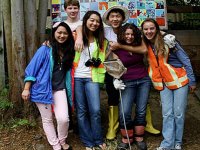Cultivate Social and Emotional Skills with Ecoliteracy
How can educators integrate the insights and achievements of the social and emotional learning movement into efforts that address today's most pressing ecological issues? The new book Ecoliterate: How Educators Are Cultivating Emotional, Social, and Ecological Intelligence offers inspiring stories, practical guidance and an exciting new model of education that shows a way to do just that. Ecoliterate reveals how educators can advance academic achievement, protect the natural world on which we depend, and foster strength, hope and resiliency. It is written by psychologist Daniel Goleman with Lisa Bennett and Zenobia Barlow of the Center for Ecoliteracy.
In Ecoliterate, the Center for Ecoliteracy has identified five vital life practices that integrate emotional, social and ecological literacy. By cultivating these practices, teachers and students expand their collective ability to nurture healthy relationships with each other and the Earth.
Practice 1: Developing Empathy for All Forms of Life
We are not the only species to experience emotions. Scientists are finding abundant evidence challenging the long-held belief that emotional capacities are unique to humans. As students expand their understanding of and compassion for other living beings, they appreciate a key ecological principle: a sustainable Earth depends upon a complex diversity of life. By practicing empathy for all forms of life, humans are more likely to act in ways that preserve diversity.
One way of learning to practice empathy is by studying other species' capabilities. For example, the African elephant is able to express a wide range of emotions, including joy, love, terror, compassion, grief, and even post- traumatic stress. As students learn more about the emotional capacities of creatures such as this endangered species, they begin to develop a sense of caring for other living beings. For more information about the complex emotional relationships in elephant communities, visit PBS.org's Unforgettable Elephants page.
Practice 2: Embracing Sustainability as a Community Practice
The most striking qualities among the activists, educators, students and artists featured in Ecoliterate are their highly developed social intelligence and inextricable connection to their communities. Communities are vital for the survival of all living beings, and the role models in Ecoliterate recognize the significance of strong networks of relationships for accomplishing their work.
One strategy for increasing students' commitments to their communities is to explore the burgeoning practice of "time banking." A time bank comprises members who exchange goods and services as wide-ranging as plumbing, handmade clothing and psychotherapy, without any money changing hands. By learning to rely on each other to fulfill their needs, these communities are building resiliency. To learn more about time banks, visit timebanks.org.
Practice 3: Making the Invisible Visible
As the distance between our actions and their consequences widens, we become less aware of the far-reaching implications of what we do. For example, electricity in California may come from coal extracted through mountaintop removal in Kentucky, yet the devastation to human health and the environment isn't evident to those in the West. Our modern lifestyle relies on resources from around the globe, making it difficult to recognize the magnitude of our impact on the planet and on future generations.
Teachers can help make the invisible visible by using Google Earth to expose students to that which they don't see in current space or time. One useful tool is the online application What's My Connection to Mountaintop Removal? After providing their zip codes, students can see links between their communities' sources of energy and mountaintop removal of coal. Visit ilovemountains.org for more background on this tool.
Practice 4: Anticipating Unintended Consequences
Many of today's environmental crises have their roots in what were initially viewed as brilliant technological advances. For example, over the past 300 years fossil fuels have energized modern progress, but their extraction and use have also caused tremendous unintended harm to humans and the environment.
Students can learn to apply systems thinking by mapping the development and use of products, technologies or practices and identifying actual or potential unintended consequences. They might start by taking a well-known invention of the past -- such as the automobile -- and identify all the resulting consequences, both positive and negative. Then they might consider an invention currently receiving attention -- such as robot cars that drive themselves -- and discuss possible unintended consequences if they become a widespread phenomenon.
Practice 5: Understanding How Nature Supports Life
Ecolilterate tells the stories of people who act out of an understanding of the ways that nature has sustained itself for nearly four billion years. By honoring nature as teacher, they learn key lessons -- such as the significance of species diversity, networks of relationships and resource conservation. Those who are ecoliterate live in ways that fulfill the needs of the present generation while simultaneously supporting nature's ability to sustain life into the future.
Students can turn to nature as teacher and discover a rich array of life-sustaining strategies. Consider the growing concern about dwindling supplies of fresh, clean water as the world's population increases. Plants and animals employ magnificently effective strategies for managing water, some of which have potential adaptations for human communities. For instance, beavers modify streams by building dams which often enhance nutrient cycling, retain sediment, and maintain species diversity.
The Center for Ecoliteracy supports and advances education for sustainable living. Learn more by visiting http://www.ecoliteracy.org/.
